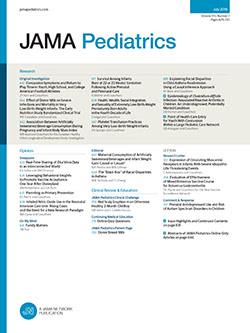School Readiness and Early Childhood Education and Care Services Among Dual Language Learners
IF 24.7
1区 医学
Q1 PEDIATRICS
引用次数: 0
Abstract
ImportanceDual language learners (DLL) (ie, children learning 2 or more languages) present lower school readiness than non-DLL children, putting DLL children at risk of later school difficulties and adverse outcomes. However, it is unclear whether participation in early childhood education and care (ECEC) services may reduce this gap.ObjectiveTo assess whether ECEC exposure may reduce the school readiness gap between DLL and non-DLL children in a population-based sample.Design, Setting, and ParticipantsThis census survey study was performed from February to May 2022 in the Canadian province of Quebec using data from the Quebec Survey of Child Development in Kindergarten, which includes all children who attended kindergarten in the 2021 to 2022 school year in public and private schools in Quebec (n = 80 587), except for Cree and Inuit territories.ExposureChildren’s ECEC arrangement before kindergarten was retrieved from register-based data and teachers and arrangements were categorized as exclusive parental care, childcare, pre-kindergarten only, or childcare and pre-kindergarten. Based on their mother tongue and language of instruction, children were classified as French speaking, English speaking, bilingual French-English speaking, or neither French nor English speaking (allophone) children, the last 2 groups of which represented the DLL category.Main Outcomes and MeasuresVulnerability in school readiness was defined as a score below the 10th percentile in any of the 5 domains of the validated Early Development Instrument (EDI): (1) physical health and well-being; (2) social competence; (3) emotional maturity; (4) language and cognitive development; and (5) communication skills and general knowledge.ResultsIn total, 80 587 children were surveyed, and 71 585 children were included in analyses. Mean (SD) child age was 6.0 (0.3) years, 34 911 children (48.8%) were female, and 18 341 children (25.6%) were DLL. English-speaking, bilingual French-English–speaking, and allophone children were more likely to be vulnerable in the EDI (769 of 2355 children [32.7%], 4814 of 13 981 children [34.4%], and 1622 of 4360 children [37.2%], respectively) than French-speaking children (13 664 of 50 890 children [26.9%]). In logistic regression analyses adjusted for social selection bias in ECEC arrangement, attending ECEC services was associated with a lower risk of being vulnerable among all language groups compared to parental care, with odds ratios ranging from 0.26 (95% CI, 0.25-0.27) to 0.96 (95% CI, 0.80-1.14), except in the emotional maturity domain. ECEC exposure was associated with reduction in vulnerabilities disparities between DLL and non-DLL children after adjusting for confounding factors, including socioeconomic status.Conclusions and RelevanceECEC services may foster school readiness for all children, especially DLL, and should be considered to reduce school inequalities.双语学习者的入学准备和幼儿教育与保育服务
重要性双语学习者(DLL)(即学习 2 种或 2 种以上语言的儿童)的入学准备程度低于非双语学习者,这使双语学习者面临日后上学困难和不良后果的风险。目标在一个基于人口的样本中,评估参与早期儿童教育和保育(ECEC)服务是否会缩小 DLL 儿童和非 DLL 儿童之间的入学准备差距。设计、地点和参与者这项普查调查研究于 2022 年 2 月至 5 月在加拿大魁北克省进行,使用的数据来自《魁北克省幼儿园儿童发展调查》(Quebec Survey of Child Development in Kindergarten),其中包括 2021 至 2022 学年在魁北克省公立和私立学校上幼儿园的所有儿童(n = 80 587),克里人和因纽特人领地除外。暴露儿童上幼儿园前的幼儿保育和教育安排是从基于登记的数据中检索的,教师和安排被分为完全由父母照顾、托儿所、仅学前班或托儿所和学前班。根据母语和教学语言的不同,儿童被分为讲法语、讲英语、讲法英双语或既不讲法语也不讲英语(异母语)的儿童,其中后两组代表了 DLL 类别。主要结果和测量方法入学准备薄弱是指在有效的早期发展工具(EDI)的以下 5 个领域中的任何一个领域的得分低于第 10 百分位数:(1) 身体健康和幸福;(2) 社交能力;(3) 情感成熟;(4) 语言和认知发展;(5) 沟通技能和常识。平均(标清)年龄为 6.0 (0.3)岁,34 911 名儿童(48.8%)为女性,18 341 名儿童(25.6%)为 DLL。与法语儿童(50 890 名儿童中的 13 664 名[26.9%])相比,英语儿童、法英双语儿童和异音儿童更有可能在 EDI 中处于弱势(分别为 2355 名儿童中的 769 名[32.7%]、13 981 名儿童中的 4814 名[34.4%]和 4360 名儿童中的 1622 名[37.2%])。在调整了幼儿保育和教育安排的社会选择偏差后进行的逻辑回归分析中,与父母照顾相比,参加幼儿保育和教育服务与所有语言群体的弱势风险较低相关,几率比从0.26(95% CI,0.25-0.27)到0.96(95% CI,0.80-1.14)不等,但情绪成熟度领域除外。在对包括社会经济地位在内的混杂因素进行调整后,接受幼儿保育和教育的机会与减少 DLL 儿童和非 DLL 儿童之间的脆弱性差异有关。
本文章由计算机程序翻译,如有差异,请以英文原文为准。
求助全文
约1分钟内获得全文
求助全文
来源期刊

JAMA Pediatrics
PEDIATRICS-
CiteScore
31.60
自引率
1.90%
发文量
357
期刊介绍:
JAMA Pediatrics, the oldest continuously published pediatric journal in the US since 1911, is an international peer-reviewed publication and a part of the JAMA Network. Published weekly online and in 12 issues annually, it garners over 8.4 million article views and downloads yearly. All research articles become freely accessible online after 12 months without any author fees, and through the WHO's HINARI program, the online version is accessible to institutions in developing countries.
With a focus on advancing the health of infants, children, and adolescents, JAMA Pediatrics serves as a platform for discussing crucial issues and policies in child and adolescent health care. Leveraging the latest technology, it ensures timely access to information for its readers worldwide.
 求助内容:
求助内容: 应助结果提醒方式:
应助结果提醒方式:


